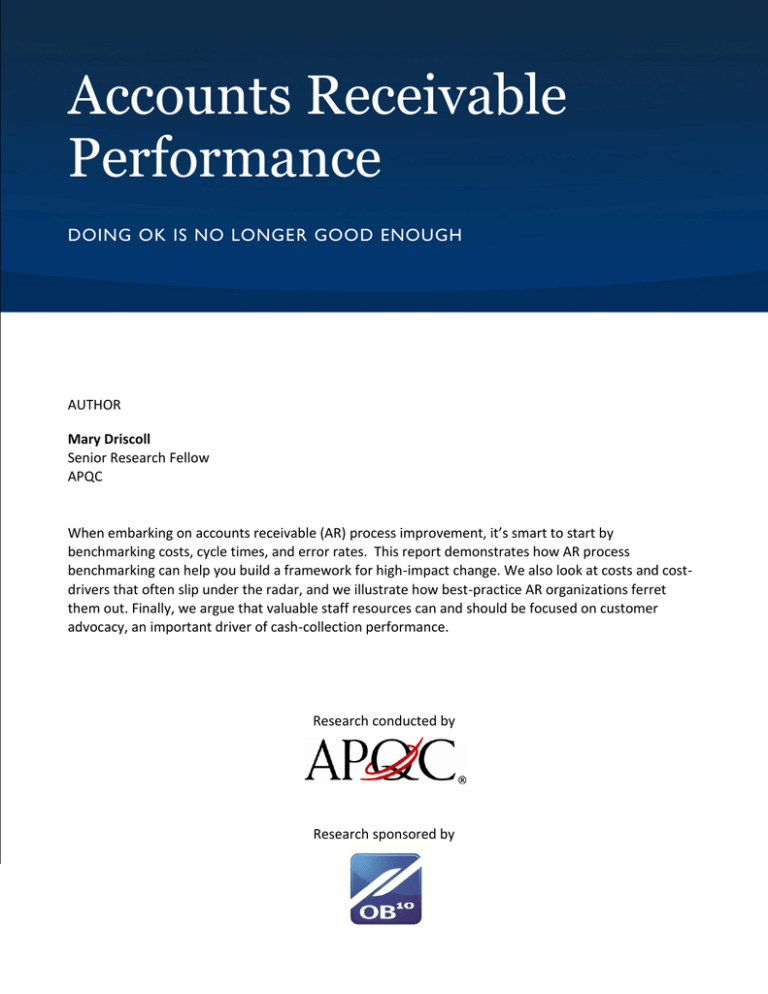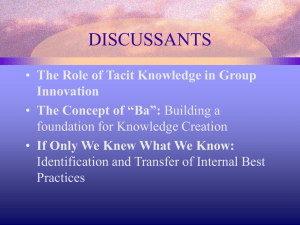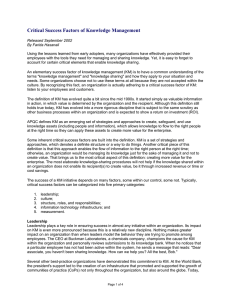
Accounts Receivable
Performance
DOING OK IS NO LONGER GOOD ENOUGH
AUTHOR
Mary Driscoll
Senior Research Fellow
APQC
When embarking on accounts receivable (AR) process improvement, it’s smart to start by
benchmarking costs, cycle times, and error rates. This report demonstrates how AR process
benchmarking can help you build a framework for high-impact change. We also look at costs and costdrivers that often slip under the radar, and we illustrate how best-practice AR organizations ferret
them out. Finally, we argue that valuable staff resources can and should be focused on customer
advocacy, an important driver of cash-collection performance.
Research conducted by
Research sponsored by
Introduction
Chances are, you think your accounts receivable (AR) process is in solid
shape. The last time you looked, operating costs seemed to be at the right
level. Staff productivity looked OK. And during the financial crisis, steps
were taken by credit and collections managers to keep days sales
outstanding (DSO) from soaring. But there are several reasons why it makes
sense to look again.
First, traditional postal services around the world are facing challenges. The U.S. Postal Service
(USPS), for example, recently proposed to eliminate next-day delivery for first-class mail and
switch to two-to-three days. In the U.K., mail strikes have been disruptive and significant
increases in postage costs have already been implemented. Clearly, companies in these locales
that send lots of invoices to customers in paper form ought to be concerned about cash
collection.
Second, as the global economy begins to grow, AR teams will face growing processing loads.
Given that many organizations cut headcount during the recession, this coming deluge of
work—mostly paper-driven and manually performed—will swamp the typical AR team.
Third, during the global economic crisis, CFOs developed a fine taste for productivity gains. Now,
they are looking for better-than-ever improvement strides in financial management (FM)
processes.1 We expect that more AR and accounts payable (AP) directors will be asked to
evaluate change programs that streamline and automate corporate billing and payment
functions, respectively.
Finally, it’s highly likely that there are hidden operating costs that can be targeted or, at the very
least, better understood. The reason some costs remain obscure is that organizations tend to
allocate costs according to function, not process. For example, some portion of the cost of
mailing paper invoices may currently land on the budget of the corporate mail facility. It might
make economic sense to examine this.
Taken together, these pressures argue in favor of AR process optimization. This white paper
examines opportunities for boosting the productivity, efficiency, and quality of activities that are
AR bedrock. The benefits include:
reduced process costs,
movement of staff from low-value to high-value tasks,
compressed cycle times for cash collection,
reduced manual data entry and, hence, lower error rates and fewer payment holds,
1
Driscoll, Mary. "Financial Improvement Programs Now Aim at Both Value and Cost." APQC Knowledge Base, 2012.
K03627
©2012 APQC ALL RIGHTS RESERVED
Page 2
www.apqc.org
better visibility of cash-flow drivers and control, and
reduced paper usage and a better carbon footprint.
Close-Up: The Costs of AR-Related
Processes
To learn whether AR processes are efficient and productive enough, organizations benchmark
specific activities across several dimensions: cost, staff productivity, cycle time, and error rate.
The primary goals are to learn where you stand relative to peers and to isolate the potential ROI
of investing in process improvement. Many enterprises do this by tapping into APQC’s Open
Standards Benchmarking program. This global resource was built in 2004 using the widely
adopted APQC Process Classification Framework, which features more than 1,200 standardized
measures spanning people, process, and technology. APQC’s seven-step validation process
ensures the highest level of accuracy of data and provides participants with detailed reports
across varying peer groups. APQC is a member-supported, non-profit organization.
Figure 1 depicts the cost of generating and submitting an invoice to a customer. There are two
views:
1. All 154 participants in APQC’s AR benchmarking survey, regardless of size, and
2. 19 participants with more than $5 billion in annual revenue.
This cost is calculated by taking the total cost of the process and dividing it by the total number
of invoices processed annually. Looking at the “all participants” view, we see a dramatic
difference between those organizations in the top-performer category ($1.17 per invoice) and
those in the bottom-performer group ($39.61). The median performance level ($7.65) also lags
the top performers significantly.2
The “all participants” view is useful, but it helps to focus more closely, forcing an “apples to
apples” comparison. For example, we see that among the group of large organizations, those
with more than $5 billion in revenue each year, top performers spend about 80 percent less to
prepare and distribute invoices than enterprises in the middle of the pack, and about 89 percent
less than those in the rear.
2
The top quartile is the performance level above which 25% of all responses occur. The bottom quartile is the
performance level above which 75% of all responses occur. The median is the middle value in a set of values that are
arranged in ascending or descending order.
K03627
©2012 APQC ALL RIGHTS RESERVED
Page 3
www.apqc.org
Total Cost of Submitting an Invoice
$50
$45
$40
$35
$30
$25
$20
$15
$10
$5
$-
$45.98
$39.61
$25.12
$7.65
$4.94
$1.17
Bottom Performer
Median Performer
All Participants
N = 154
Top Performer
Revenue > $5 Billion
N = 19
Figure 1
How do the top performers do it? The answer, in short, is that the pioneers (who are in the
minority at the moment) cut way back on the number of invoices they present to customers
using paper. The good news for those who want to move up the maturity curve is that there is
plenty of opportunity to reap cost-savings here. Approximately 86 percent of organizations who
participated in a third-party survey reported that they submit invoices today in paper form.3
Seventy percent report sending invoices via e-mail or fax. Either way, there is a lot of paper
handling, envelope stuffing, file uploading, or scanning involved.
With labor costs representing the biggest contributor to the overall cost of financial operations,
the answer has to be streamlining and automating core AR workflows. That means investing in a
solution that offers the ability to automatically present bills in formats that the customer
prefers, whether it’s a supplier-created web portal, buyer web portal, or a third-party einvoicing solution. Surely, you need to be customer friendly—you cannot force them to receive
invoices they are not set up to accept. Still, it is entirely possible to automate the AR end of the
billing-to-collection cycle to cut processing costs significantly.
Some solution providers in this space promise to reduce AR processing costs in the 40-to-60
percent range. It’s no coincidence, perhaps, that APQC finds a growing number of CFOs and
their teams looking at mature technology solutions that can easily integrate with existing
financial management systems.
3
A survey conducted in January 2012 by OB10, a global e-invoicing network, and The Institute of Financial
Operations, a not-for-profit, guidance-setting association for the accounts payable and the accounts receivable
profession.
K03627
©2012 APQC ALL RIGHTS RESERVED
Page 4
www.apqc.org
Better still, automating steps across the spectrum of AR activities addresses costs that are not
easily isolated by benchmarking. These costs stem from:
time spent printing, stuffing envelopes, and mailing invoices,
office equipment needed to print out billing data or invoices on paper, which then has to be
delivered to customers,
paper and postage,
use of mail room equipment and staff to mail out invoices,
time spent chasing unpaid invoices, and
time spent managing disputes due to billing errors introduced during manual data re-keying.
The reason some of these costs are not clearly detected by high-level benchmarking often rests
with less-than-exact cost allocations. For example, some AR-related work may be carried out by
staff that belongs to the corporate mail facility, and their costs may never be fully attributed to
AR. So, AR will tend to under-report its total cost of customer invoicing. This is the kind of detail
that some senior finance executives now want to examine and address.
Further evidence of the opportunities to reduce costs appears in Figure 2 and Figure 3. These
perspectives involve:
1. the average size of the staff needed to get invoices out to customers over the course of a
year and
2. the relative productivity of the individual full-time equivalent (FTE).
Once again, gaps between the top and bottom performers are staggering. And once again,
automation is the key.
Note that finance organizations that are truly committed to continuous process improvement
aim much higher than headcount reduction. The end-game is to liberate talented staff from
routine, low-value chores and apply them instead to analytical tasks that can make a difference
to business performance. One example: liberating AR people so they can better understand the
root causes of payment-pattern aberrations. AR aging can tell you when customers are past due,
but that exercise won’t explain why payments are sometimes held back. If you can assign people
to isolate the root causes of recurring payment halts, you may find that there are things your
organization can do differently to prevent them.
K03627
©2012 APQC ALL RIGHTS RESERVED
Page 5
www.apqc.org
Number of FTEs Processing Customer Invoices per $1 Billion Revenue
35
28.7
30
25
20
15
11.6
10
4.6
5
0
Bottom Performer
Median Performer
Top Performer
N = 236
Figure 2
Number of Invoices Processed per Assigned FTE
60,000
56,000
50,000
40,000
30,000
20,000
10,000
12,801
2,556
Bottom Performer
Median Performer
Top Performer
N = 189
Figure 3
K03627
©2012 APQC ALL RIGHTS RESERVED
Page 6
www.apqc.org
Liberating Talent for Truly ValueAdding Work
To fully appreciate the productivity boost possible in AR, it helps to work through the math and
determine how much money can be saved by reducing the number of FTEs allocated to
customer invoicing.
Here’s a hypothetical case: a company receives and processes 50,000 customer payments
annually, and it spends on average $56,000 in personnel costs per FTE. Let’s assume that the
average FTE handles 11,000 receipts per year, which is the median figure for this metric. The
company needs 4.5 FTEs to manage this processing load. But if this company could double its
staff productivity so that each FTE handled 22,000 (not 11,000) receipts, it could enjoy a cost
savings of $127,000 because the number of needed FTEs would fall from 4.5 to 2.3.
Alternatively, these FTEs can focus on higher-value activities such as analyzing customer
payment patterns or working with the treasury department to generate more precise views of
cash-flow drivers. One can easily imagine a whole host of value-adding work that could be
tackled.
GETTING THE RIGHT PE OPLE IN THE RIGHT JOBS
Is the analytical talent that resides in your AR staff leveraged properly? The answer has to be
“no” if staffers are tasked with manually-driven tasks such as paper-based invoicing and
payment processing.
Consider this: many large corporations (that are not financially stressed) are more than happy to
pay their bills within a consistent timeframe; for example, 30 days after the date the invoice was
received. When they are noticeably late, there is usually a problem that has triggered a payment
“hold,” (perhaps they don’t pay invoices when they have received a partial shipment). You can
increase the likelihood that key accounts will pay on time by modeling their payment trends and
(a) identifying process constraints and (b) mistake-drivers (Figure 4 shows how top performers
have 97.8 percent of invoiced items paid in full the first time).
Eventually, you want to join the top performers, as illustrated in Figure 7. Getting there,
however, requires effective analytical work on behalf of AR staff.
K03627
©2012 APQC ALL RIGHTS RESERVED
Page 7
www.apqc.org
Percentage of Invoiced Line Items Paid in Full the First Time
100%
97.8%
94.0%
95%
90%
85%
84.0%
80%
75%
Bottom Performer
Median Performer
Top Performer
N = 288
Figure 4
When AR staffers are liberated from the tedium of generating and sending out paper invoices,
they can turn their attention to more value-adding activities such as payment-pattern analysis.
And directing their focus in this manner can lead to process improvements that allow you to
better manage DSO.
Here are other value-adding tasks for those people who no longer have to manually generate
and send out invoices:
establish procedures to increase effective monitoring of past-due invoices,
identify customers who usually take cash discounts and have a history of using these, and
inquire immediately if the discount date is missed,
establish a split routine to examine past-due invoices, one for revenue volume and one for
product segment, or
use AR aging, view customers past-due invoices (by five or 10 days), and run this weekly or
biweekly. The point is to identify payment issues and resolve them quickly.
Improve Processes to Ensure Timely
Cash Collection
It is also vital to examine the operational drivers across the cash-conversion cycle. One focus in
this paper is DSO. Start by identifying how much working capital is unnecessarily trapped in your
K03627
©2012 APQC ALL RIGHTS RESERVED
Page 8
www.apqc.org
receivables balance. Then study whether there are steps you can take to address the situation.
In the short term, you probably cannot influence the ways in which your key-account sales staff
strike deals and set payment terms in a tough marketplace. But process improvements can
make a meaningful impact. For example, you may learn that you can increase the efficiency and
effectiveness of your billing processes and cut a day or more off your DSO metric.
There are clearly opportunities here. We see large gaps (between the best and worst
performers) when looking at the time it takes to create error-free invoices. Figure 5 shows the
relative performance of all participants in APQC’s Open Standards Benchmarking database in
accounts receivable, along with a look at one industry-specific cut of the data: durable goods. As
mentioned earlier, looking at the “all participants” view is a first step only. Once you start to
compare peer groups, in this case industry peers, you get a clearer view of what you can achieve
by addressing process weak spots.
Average Cycle Time in Days to Generate Complete and Correct Billing Data
7
6
6
5
5
4
3
3
2
2
1
1
1
Bottom Performer
Median Performer
Top Performer
All Participants
Durable Goods
N = 540
(Aerospace, Automotive, and Industial Products) N = 82
Figure 5
The chart above clearly indicates that the top performers, using both views of the data, have a
significant jump on the worst performers. We can argue with assurance that many of the top
performers have taken steps to rid their billing processes of the root causes of invoice errors,
which are the primary drivers of payment hold-ups. By streamlining the billing process to reduce
error-drivers, cycle speed is also accelerated. Moreover, we can assert that those organizations
that have automated the process for generating invoices are most likely to find themselves in
the top performing category.
K03627
©2012 APQC ALL RIGHTS RESERVED
Page 9
www.apqc.org
Cutting Invoice-Dispute Times
Disputes with customers over what exactly was procured, received, and billed is another difficult
area. Figure 6 looks at the time it takes to resolve an invoice error. The top performers move
nearly four times faster when it comes to sorting out invoice errors. The take-away here is: if
you can liberate AR talent from paper-shuffling tasks (see “Liberating Staff for Truly ValueAdding Work” above), you can devote that high-I.Q. talent to customer-focused service and
position your AR people as customer advocates. For example, you may set out to reduce the
amount of time AR staff spends on manual cash applications. If that effort succeeds, the staff
will have more time to spend on credit- or collections-related work.
Cycle Time in Days to Resolve an Invoice Error
16
14
14
12
10
8
7
6
3.64
4
2
Bottom Performer
Median Performer
Top Performer
N = 469
Figure 6
There are a number of attractive alternatives to submitting paper invoices through the mail.
Sending invoices by e-mail, for example, can certainly help reduce the time it takes for paper to
be delivered to your customer’s office. Some organizations also rely on faxing their invoices,
hoping to reduce by a day or two the time it takes for invoices to arrive by mail. Although these
options hold some benefit, they are far less efficient than electronic solutions such as a supplier
portal, customer portal, electronic data interchange (EDI), or an e-invoicing network.
There are a number of organizations that offer portals to their customers as a way to streamline
their own invoice submission processes. But, not all customers will be inclined to connect to and
accept invoices from these portals, as most deal with dozens – if not hundreds – of different
suppliers with different portal structures. Customers may also have their own portals, and the
challenge for suppliers can be tailoring invoices for several different customers using many
K03627
©2012 APQC ALL RIGHTS RESERVED
Page 10
www.apqc.org
unique portals. Although EDI is oftentimes more attractive than paper, e-mail, and fax, it usually
requires heavy IT investment and a separate connection for each customer. Alternatively, a welldesigned e-invoicing network not only significantly streamlines the invoice submission process,
but also allows an organization to submit invoices from virtually any type of billing system,
offering the convenience of sending invoices to multiple customers using a single connection.
Surely, your customers will insist that they retain choice over how invoices are presented to
their AP departments. You cannot force them. Rather, you want to offer suitable choices as they
evolve their own AP functions. E-invoicing, of course, is instant and continuous. From the
supplier’s perspective, there is no longer any need to use a batch processing approach, which by
definition means some invoices wait for others to catch up. Meanwhile, the invoice receiver
gains important leverage over operating costs and the opportunity to boost FTE productivity.
Customers pushing the envelope can leverage e-invoicing to gain better control over cash flow
and to reduce working capital requirements.
The Power of Cutting DSO
So, what could be the hard-dollar cash-flow boost of an AR process improvement that cuts DSO
by, say, a portion of a day, or even a full day? Evidence for the power of DSO improvement
comes from Dr. Stephen Timme, an internationally known expert in working capital
management. He is currently an adjunct professor at the Georgia Institute of Technology and
president of FinListics Solutions, a financial software and analytical services firm.
His model below shows, for example, that a median performing company with $30 billion in
revenue that can cut cycle time by 20 percent (actually less than one day) can witness an
estimated one-time $34 million increase in balance sheet cash (Figure 7).
K03627
©2012 APQC ALL RIGHTS RESERVED
Page 11
www.apqc.org
DSO Operational KPI Improvement Example4
Figure 7
A Final Word
The principles, concepts, and enabling technologies that can move corporate payment systems
into the digital age are now relatively advanced. So, take a page from the pioneers and
investigate not only the potential one-time cost-savings (the efficiency play), but also the myriad
benefits to be gained from pushing for process and resource effectiveness.
Our research finds that the top performers:
cut way back on the number of invoices they present to customers using paper. Top
performing companies streamline and automate core AR workflows by investing in a
solution that offers the ability to automatically present bills in formats that the customer
prefers,
4
Though inspired by a real company, this example does not represent a specific situation at an existing company. Any
resemblance to an actual entity is unintended. This example was developed solely as an illustration for discussion and
is not intended to serve as an endorsement, source of primary data, or illustration of effective or ineffective
management.
K03627
©2012 APQC ALL RIGHTS RESERVED
Page 12
www.apqc.org
are able to identify costs that are not easily isolated by benchmarking, such as time spent
handling and mailing invoices, paper and postage, use of mail room, and time spent
managing disputes,
liberate talent by having staff members work on value-added tasks. They can make a greater
impact by focusing on establishing clear procedures for past-due invoices, monitoring
whether customers are taking advantage of early-pay discounts, or determining whether
insights about past-due invoices can be gained by categorizing by revenue volume or
product segment
look for ways to reduce invoice-dispute times by having members of staff positioned as
customer advocates focused on customer advocates, and
pay close attention to how they can reduce cycle times to generate complete and correct
billing data, knowing that any reduction in DSO can have a positive impact on their
organization’s cash position.
ABOUT APQC
APQC is a member-based nonprofit and one of the leading proponents of benchmarking and
best practice business research. Working with more than 500 organizations worldwide in all
industries, APQC focuses on providing organizations with the information they need to work
smarter, faster, and with confidence. Every day we uncover the processes and practices that
push organizations from good to great. Visit us at www.apqc.org and learn how you can make
best practices your practices.
K03627
©2012 APQC ALL RIGHTS RESERVED
Page 13
www.apqc.org
SPONSOR’S PERSPECTIVE
About the Research
OB10 sponsored this research because of a desire expressed by accounts receivable and credit
professionals for information regarding the costs associated with the invoice submission
process. We believe organizations will benefit from this information and be better equipped to
make more informed decisions regarding their invoice-submission practices.
About OB10
OB10 is the leading global B2B e-invoicing network. Founded in 2000, the company has emerged
as the world's most trusted e-invoicing network, providing a secure global service. The OB10
Network enables companies to send and receive error free, tax compliant invoices around the
globe without the need to install any additional hardware or software. More than 130 multinational clients receive electronic invoice data from over 120,000 suppliers operating in 150
countries. Customers of all sizes optimize their invoice processes with OB10 and benefit from
improved efficiency and transparency.
OB10 e-invoicing completely removes paper from the invoice process. The solution results in no
paper, scanning, or OCR. Just straight-through, machine-to-machine processing of validated
invoice data from a supplier’s billing system directly into its customer's accounts payable
system.
Through its comprehensive enrollment program that connects suppliers to the OB10 network
through a time-tested process, OB10 enables more than 120,000 suppliers to send paperless
invoices simply and quickly. OB10 will engage, educate, and enroll a company’s suppliers –
regardless of their geographic location – using its multi-lingual supplier enrollment team. This
allows suppliers to take advantage of a solution that is non-intrusive to its internal business
processes, cost effective, and easy to use.
In addition to e-invoicing, OB10 offers a complete range of related solutions such as purchaseorder services, payment-status services, invoice archiving and a discount-capture capability.
To learn more about OB10, visit our website at www.ob10.com.
Editor’s note: This research program was made possible with funding by OB10; however, APQC
remains solely responsible for the data and analysis offered.
Copyright ©2012 APQC, 123 North Post Oak Lane, Third Floor, Houston, Texas 77024‐7797 USA
All terms such as company and product names appearing in this work may be trademarks or registered trademarks of
their respective owners. This report cannot by reproduced or transmitted in any form or by any means electronic or
mechanical, including photocopying, faxing, recording, or information storage and retrieval.
K03627
©2012 APQC ALL RIGHTS RESERVED
Page 14
www.apqc.org



